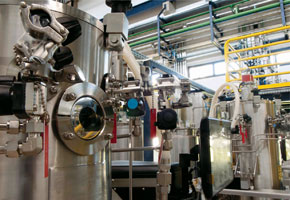
LÉO RAMOSFrom left to right, Wesley Ambrósio, Caio Fortes, Daniel Atala and Marco Souza, at BP Biofuels headquarters in São PauloLÉO RAMOS
BP has been active in Brazil for more than 50 years, with operations in oil and natural gas, lubricants and aviation fuels. Since 2008 it has invested through BP Biofuels in renewable fuels with a focus on first-generation ethanol, in which sucrose from sugarcane is fermented to produce alcohol. To do this BP entered into agreements with research and training institutions. “The most natural way is to fund research at well-established centers,” says Wesley Ambrósio, 43, chief technology officer of BP Biofuels, based in São Paulo. In April 2012, for example, BP and FAPESP announced an agreement to fund bioenergy research projects in association with universities and research institutes in the state of São Paulo. The agreement provides for an investment of up to $50 million, divided equally between the two parties for a period of up to 10 years. “The program with FAPESP is the first we have developed with outside entities to try to cover the entire range of ethanol research, development and application,” says Ambrósio, a chemical engineer with undergraduate and master’s degrees from the State University of Campinas (Unicamp) and graduate studies in business administration at the Getulio Vargas Foundation (FGV).
In October 2012, BP signed a new agreement with the Brazilian Bioethanol Science and Technology Laboratory (CTBE) in Campinas to develop a sugarcane juice fermentation process to increase its alcohol content prior to distillation. The average alcohol content of the Brazilian juice at this stage is only 9% of the total volume, which yields a large volume of vinasse (liquid effluent resulting from the ethanol production process). Participants will invest $2 million in the project, divided equally over two years.
“We know that the first generation offers great opportunities, which range from agricultural production, starting with the selection of sugarcane varieties suited to cutting-edge production, the development of new technologies for planting and harvesting and the use of geotechnology, to the industrial, with extraction and treatment of the juice and its final conversion into products such as ethanol, sugar and electricity,” says Ambrósio. He leads a team of 12 researchers, made up primarily of engineers and biologists hired to implement the projects. “Our idea is to take advantage of opportunities in the first generation so that we are well positioned for the second generation, which is cellulosic ethanol,” says the director of technology who has spent most of his career in the chemical industry, as well as in oil and shipbuilding.

Léo RamosLaboratory tests of alcohol fermentation at CTBELéo Ramos
BP has about 90,000 employees and a presence in over 30 countries. In 2011, its global net revenue was $375.5 billion. In Brazil, BP has about 5,000 employees. In 2011, BP Biofuels crushed 4.5 million tons of sugarcane. “We have three plants in operation in Brazil: two in the state of Goiás and one in the state of Minas Gerais, and growth targets up to 2020 by duplicating existing units and constructing new ones, using technologies that provide greater efficiency and profitability,” says Daniel Atala, 38, researcher, one member of the BP Biofuels technology team and a specialist in industrial processes. With an undergraduate degree in food engineering from the Federal University of Rio Grande (Furg), Atala earned his master’s and PhD in the same field and did a post-doctorate in chemical engineering, all at Unicamp with FAPESP grants.
In his PhD dissertation he defended a new technique of extractive fermentation for ethanol, which led to a patent application and the Young Scientist Award given by the Bunge Foundation in 2007 in the area of agro-energy. The proposed method states that under normal conditions the fermentation process is strongly inhibited by the ethanol that is produced, which causes the yeast to reduce its metabolic activity and lose its fermenting strength. However, the new process, which takes place in a low pressure environment (vacuum), where evaporation takes place at room temperature (around 33°C), the ethanol is removed from the medium before it has a chance to exert an influence on yeast performance. “The removal of ethanol from the culture medium as it is being produced makes the yeast more productive” says Atala.
During his post-doctoral studies, the Sugarcane Technology Center (CTC), in the city of Piracicaba, São Paulo State, was interested in developing the technology on a semi-industrial scale. Atala was hired in 2006 as a researcher in the area of alcohol production, where he built a vacuum-type pilot plant for extractive fermentation, and he remained there until July 2011, when he left to join the research group at BP Biofuels. “Technological advances applied to the first generation process may set a new production standard for the sector,” he says. For the researcher, what distinguishes BP in the current setting — “where technologies used today are basically the same as those of 30 years ago, with minor modifications” — is that it has several technology development centers around the world.
Internacional interaction
At one of these centers, located in San Diego, for example, researchers are engaged in innovative projects in the biofuels sector, but with a focus on second-generation ethanol, the lignocellulosic materials. These are made from biomass waste such as bagasse and cane straw. “There is a lot of interaction between the Brazilian team and their counterparts in San Diego,” says Ambrósio, who reports directly to Tom Campbell, the technology vice president of BP Biofuels.

Léo RamosFermentor with vinasse from sugarcaneLéo Ramos
The company has announced investments of $500 million over 10 years on research conducted by the Energy Biosciences Institute (EBI) for renewable energy development from biotechnology — an initiative led by the University of California at Berkeley, in partnership with the University of Illinois, both in the United States. The EBI plans to investigate the application of biotechnology in areas such as cellulosic fuels, petroleum microbiology, biolubricants and carbon biosequestration. “There are three main criteria that BP believes are important for biofuels: they should be low carbon, low cost and large scale. The sum of these elements will result in the fourth: a sustainable biofuel,” says Ambrósio. Sugarcane ethanol is a fuel that meets all these four criteria.
In partnership with DuPont, BP formed a joint venture called Butamax Advanced Biofuels, which in 2010 opened its first laboratory in Latin America dedicated to the research and development of biobutanol from sugarcane, a new renewable fuel to be added to gasoline. The laboratory is located in Paulinia, 18 kilometers from Campinas in the state of São Paulo. It is expected to reach a production level of 7.6 billion liters by 2020, which would be intended mainly for the United States and Europe, whose markets have regulations that set targets for minimum consumption of biofuels to reduce emission levels of greenhouse gases, in addition to Asia.
In the US market, where biobutanol is scheduled to begin production on a commercial scale in 2013 at a plant in Minnesota, the product will be made from corn. According to the company, the advantage of biobutanol compared to other types of renewable fuels, including ethanol, lies in its energy content. While ethanol has two carbons in its molecular chain, biobutanol has four, which provides more energy per unit of volume. BP also has a line of research in collaboration with the Dutch food and chemicals group, DSM, in the United States for the production of biodiesel from sugarcane.

Léo RamosPilot plant tests experiments on pre-industrial scaleLéo Ramos
Marco Souza, 55, is also part of the BP research group and is responsible for optimizing industrial fermentation, an area in which he has worked since finishing a degree in medical biology from the Pontifical Catholic University of Campinas (PUC) 32 years ago. After graduation he was hired by a plant in Guariba, 64 kilometers from Ribeirão Preto, in the state of São Paulo, where, in collaboration with Copersucar, he set up a laboratory to study industrial contamination at all stages of production — sugarcane harvesting, milling and product manufacturing. For both his master’s degree and PhD in microbiology at UNESP in the city of Jaboticabal, he researched contaminants in the fermentation process.
Harmful effects
“In the presence of contaminants, yeast has a deleterious effect on the production of ethanol,” he says. Souza also worked for four years at CTC and has been at BP since May 2011: “Our main project consists of monitoring fermentation in real time, using technologies and tools utilized in other industries, such as chemistry.” Until recently fermentation was seen as a black hole, according to Souza. That is, the process begins with a certain amount of sugar, but ends with no equivalent amount in ethanol, due to losses during the process and because of the measuring problems that are inherent to commonly used technologies.
The inefficiency of the process is related not only to the industrial plant, but also to the physiological and kinetic (speed) aspects involved when yeast converts sugar into ethanol. The speed of the transformation process depends on the enzymes produced, the nutritional condition of the yeast and the quality of the feedstock. When fermentation is well controlled, there is a gain in processing the feedstock and in the distillation itself. During fermentation, because of impurities from the sugarcane juice, some ethanol and other alcohols and secondary products are produced by the yeast through alternative metabolic pathways. “Decreasing the number of secondary products improves the manufacturing of ethanol,” says Souza. Besides efficiency gains, the product obtained is of a better quality to compete in the market.
 At the initial point of ethanol production, which begins in the field, the technology team relies on the support of Caio Fortes, 33, a researcher and agronomist who graduated from the Federal University of São Carlos (UFSCar) in the city of Araras, with a master’s degree and PhD from the Luiz de Queiroz School of Agriculture (Esalq /USP) in the city of Piracicaba. “I handle the study of sugarcane varieties, research into alternative feedstock such as sweet sorghum, soil management, best agricultural practices, irrigation and machinery,” says Fortes, who worked in the Cocal plants and for Grupo São Martinho and at CTC as a researcher for four years. While with the São Martinho Group, where he served as coordinator of agricultural quality and industrial planning, he started his PhD at the Center for Nuclear Energy in Agriculture (Cena) of USP, which closed in 2010. There he studied nitrogen fertilization and the management of straw cane harvesting without burning. He has been at BP since 2008, where he began in the business development group, analyzing potential business opportunities in acquisitions.
At the initial point of ethanol production, which begins in the field, the technology team relies on the support of Caio Fortes, 33, a researcher and agronomist who graduated from the Federal University of São Carlos (UFSCar) in the city of Araras, with a master’s degree and PhD from the Luiz de Queiroz School of Agriculture (Esalq /USP) in the city of Piracicaba. “I handle the study of sugarcane varieties, research into alternative feedstock such as sweet sorghum, soil management, best agricultural practices, irrigation and machinery,” says Fortes, who worked in the Cocal plants and for Grupo São Martinho and at CTC as a researcher for four years. While with the São Martinho Group, where he served as coordinator of agricultural quality and industrial planning, he started his PhD at the Center for Nuclear Energy in Agriculture (Cena) of USP, which closed in 2010. There he studied nitrogen fertilization and the management of straw cane harvesting without burning. He has been at BP since 2008, where he began in the business development group, analyzing potential business opportunities in acquisitions.

